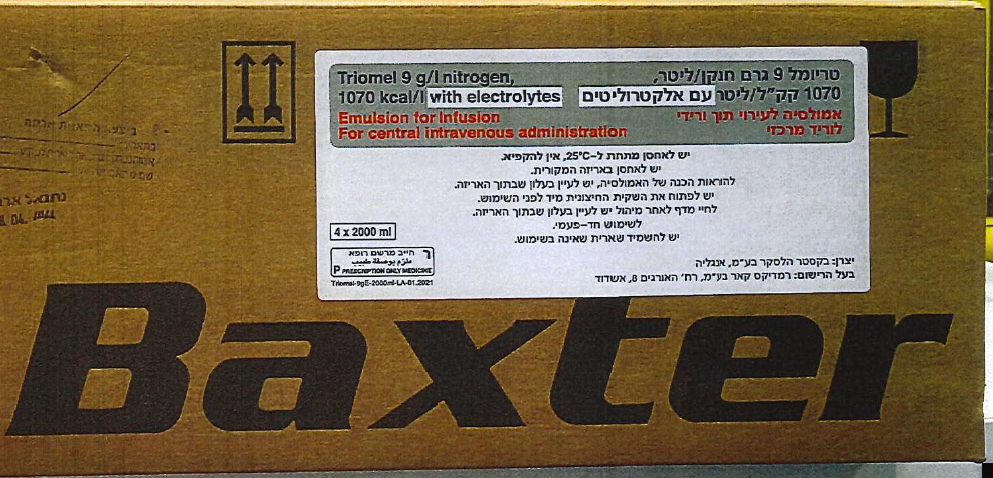Quest for the right Drug

טריומל 9 גרם חנקן/ליטר, 1070 קק"ל/ליטר עם אלקטרוליטים TRIOMEL 9 G/L NITROGEN 1070 Kcal/L WITH ELECTROLYTES (ALANINE, ARGININE, ASPARTIC ACID, CALCIUM CHLORIDE DIHYDRATE, GLUCOSE MONOHYDRATE, GLUTAMIC ACID, GLYCINE, HISTIDINE, ISOLEUCINE, LEUCINE, LYSINE, MAGNESIUM CHLORIDE, METHIONINE, PHENYLALANINE, POTASSIUM CHLORIDE, PROLINE, SERINE, SODIUM ACETATE TRIHYDRATE, SODIUM GLYCEROPHOSPHATE HYDRATE, SOYA BEAN OIL REFINED + OLIVE OIL REFINED, THREONINE, TRYPTOPHAN, TYROSINE, VALINE)
תרופה במרשם
תרופה בסל
נרקוטיקה
ציטוטוקסיקה
צורת מתן:
תוך-ורידי : I.V
צורת מינון:
תחליב לאינפוזיה : EMULSION FOR INFUSION
עלון לרופא
מינוניםPosology התוויות
Indications תופעות לוואי
Adverse reactions התוויות נגד
Contraindications אינטראקציות
Interactions מינון יתר
Overdose הריון/הנקה
Pregnancy & Lactation אוכלוסיות מיוחדות
Special populations תכונות פרמקולוגיות
Pharmacological properties מידע רוקחי
Pharmaceutical particulars אזהרת שימוש
Special Warning עלון לרופא
Physicians Leaflet
Adverse reactions : תופעות לוואי
4.8 Undesirable effects Potential undesirable effects may occur as a result of inappropriate use (for example: overdose, excessively fast infusion rate) (see sections 4.4 and 4.9). At the beginning of the infusion, any of the following abnormal signs (sweating, fever, shivering, headache, skin rashes, dyspnoea) should be cause for immediate discontinuation of the infusion. The adverse drug reactions (ADRs) reported with TRIOMEL 9g/l nitrogen 1070 kcal/l in a randomized, double-blind, active-controlled, efficacy and safety study, are listed in the table below. Twenty-eight patients with various medical conditions (i.e., postsurgical fasting, severe malnutrition, enteral intake insufficient or forbidden) were included and treated; patients in the TRIOMEL 9g/l nitrogen 1070 kcal/l group received drug product up to 40 ml/kg/d over 5 days. The pooled data from clinical trials and the postmarketing experience indicate the following adverse drug reactions (ADRs) related to TRIOMEL: System Organ Class MedDRA Preferred Term Frequencya Immune System Disorders Hypersensitivity reactions including Not knownb hyperhidrosis, pyrexia, chills, headache, skin rash (erythematous, papular, pustular, macular, generalised rash), pruritus, hot flush, dyspnoea Cardiac Disorders Tachycardia Commona Metabolism and Nutrition Decreased appetite Commona Disorders Hypertriglyceridemia Commona Gastrointestinal Disorders Abdominal pain Commona Diarrhea Commona Nausea Commona Vomiting Not knownb Vascular Disorders Hypertension Commona General disorders and Extravasation which may result at infusion site Not knownb administration site conditions level in: pain, irritation, swelling/oedema, erythema/warmth, skin necrosis, blisters/vesicles, inflammation, induration, skin tightness a: Frequency is defined as very common (≥ 1/10); common (≥ 1/100 to < 1/10); uncommon (≥ 1/1,000 to < 1/100); rare (≥ 1/10,000 to < 1/1,000); very rare (< 1/10,000); or not known (cannot be estimated from the available data). b: ADRs reported during post-marketing experience with TRIOMEL The following class-like adverse drug reactions (ADRs) have been described in other sources in relation to similar parenteral nutrition products; the frequency of these events is not known. • Blood and lymphatic system disorders: thrombocytopenia • Hepatobiliary disorders: cholestasis, hepatomegaly, jaundice • Immune system disorders: hypersensitivity • Injury, poisoning and procedural complications: Parenteral nutrition associated liver disease (see section 4.4, sub-section “Hepatobiliary disorders”) • Investigations: blood alkaline phosphatase increased, transaminases increased, blood bilirubin increased, elevated liver enzymes • Renal and urinary disorders: azotemia • Vascular disorders: Pulmonary vascular precipitates (pulmonary vascular embolism and respiratory distress) (see section 4.4). Fat overload syndrome (very rare) Fat overload syndrome has been reported with similar products. This may be caused by inappropriate administration (e.g., overdose and/or infusion rate higher than recommended, see section 4.9); however, the signs and symptoms of this syndrome may also occur at the start of an infusion when the product is administered according to instructions. The reduced or limited ability to metabolize the lipids contained in TRIOMEL 9 g/l nitrogen 1070 kcal/l with electrolytes, emulsion for infusion, accompanied by prolonged plasma clearance may result in a “fat overload syndrome”. This syndrome is associated with a sudden deterioration in the patient’s clinical condition and is characterized by findings such as fever, anemia, leukopenia, thrombocytopenia, coagulation disorders, hyperlipidemia, liver fatty infiltration (hepatomegaly), deteriorating liver function, and central nervous system manifestations (e.g., coma). The syndrome is usually reversible when infusion of the lipid emulsion is stopped. Reporting of suspected adverse reactions Reporting suspected adverse reactions after authorisation of the medicinal product is important. It allows continued monitoring of the benefit/risk balance of the medicinal product. Any suspected adverse events should be reported to the Ministry of Health according to the National Regulation by using an online form https://sideeffects.health.gov.il

שימוש לפי פנקס קופ''ח כללית 1994
לא צוין
תאריך הכללה מקורי בסל
לא צוין
הגבלות
לא צוין
מידע נוסף
